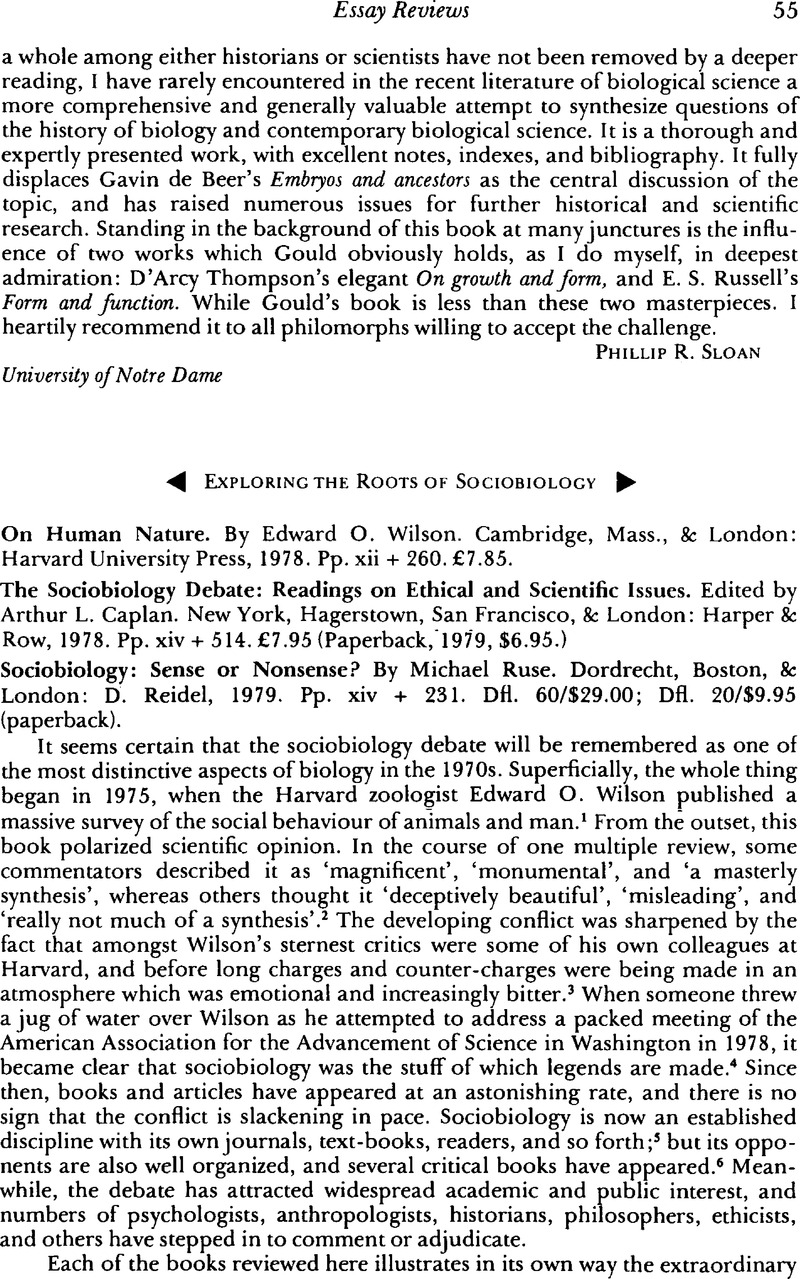Article contents
Exploring the Roots of Sociobiology
Published online by Cambridge University Press: 05 January 2009
Abstract

- Type
- Essay Reviews
- Information
- Copyright
- Copyright © British Society for the History of Science 1980
References
NOTES
1 Wilson, E. O., Sociobiology: the new synthesis, Cambridge, Mass. & London, 1975.Google Scholar
2 ‘MuUiple review of Wilson's Sociobiology’, Animal behaviour, 1976, 24, 698–718.Google Scholar
3 See for example Allen, E. et al. , letter to the editor, New York review of books, 1975, 22, 43–4Google Scholar; Allen, E. et al. , ‘Sociobiology: another biological determinism’, BioScience, 1976, 26, 182–6Google Scholar; Wilson, E. O., letter to the editor, New York review of books, 1975, 22, 60–1Google Scholar; and Wilson, E. O., ‘Academic vigilantism and the political significance of Sociobiology’, BioScience, 1976, 26, 183, 187–90.CrossRefGoogle ScholarPubMed The two exchanges of letters are reprinted in Caplan, , pp. 259–68, 280–303.Google Scholar
4 Reported in New scientist, 23 02 1978, 77, 486.Google Scholar
5 See for example Barash, D. P., Sociobiology and behaviour, New York, Oxford, & Amsterdam, 1977Google Scholar; and Clutton-Brock, T. H. and Harvey, P. H. (eds.), Readings in Sociobiology, Reading & San Francisco, 1978.Google Scholar
6 See for example Sahlins, M., The use and abuse of biology, London, 1977CrossRefGoogle Scholar; and The Ann Arbor Science for the People Editorial Collective, Biology as a social weapon, Minneapolis, 1977Google Scholar, which I have reviewed in Radical science journal, 1979, 8, 105–9.Google Scholar
7 Smith, J. M., ‘In the safety of confusion’ New scientist, 29 03 1979, 81, 1051.Google Scholar
8 Dawkins, R., ‘Defining Sociobiology’, Nature, 2 08 1979, 280, 427–8.CrossRefGoogle Scholar
9 See Wilson, E. O., op. cit. (1), pp. 63–4Google Scholar; Lewontin, R. C., ‘Sociobiology—a caricature of Darwinism’, in Suppe, F. and Asquith, P. (eds.), PSA 1976; Proceedings of the 1976 biennial meetings of the Phitosophy of Science Association, vol. ii, East Lansing, Michigan, 1977Google Scholar; and Miller, L. G., ‘Fated genes’, Jouunal of the history of the behavioural sciences, 1976, 12, 183–90.3.0.CO;2-O>CrossRefGoogle Scholar
10 Sahlins, , op. cit. (5), pp. 71–91.Google Scholar
11 Kuhn, T. S., The structure of scientific revolutions, Chicago. 1962, pp. 136–9.Google Scholar
12 See for example, ‘Sociobiology: scientific bandwagon or travelling medicine show?’, Transaction society, 1978, 15, 50–9Google Scholar; ‘The sociology of sociobiology’, New scientist, 21 09 1978, 79, 862–5Google Scholar; and ‘Altruism in science: a sociobiological model of co-operative behaviour among sciemists’, Animal behaviour, 1978, 26, 685–97.Google Scholar
13 The conference took place on Friday 29 September 1978 at the Geological Society of London. The proceedings are shortly to be published, together with a number of additional contributions, in the form of a book.
14 Dawkins, , op. cit. (8), p. 427.Google Scholar
15 Ibid.
16 Prominent among the many criticisms of human sociobiology is the argument that it rests upon a projection of human experience—in the form of concepts such as division of labour, hierarchy, caste, etc.—into nature. (See for example Biology as a social weapon, op. cit. (6), p. 141.)Google Scholar There are now one or two historical studies which address this problem (see for example Haraway, D., ‘Animal sociology and a natural economy of the body politic’, Signs, 1978, 4, 21–60CrossRefGoogle Scholar, and Crocker, D. R., ‘The ethological concept of dominance and its popularisation’, University of Manchester MSc dissertation, 1979)Google Scholar; but it is fair to say that a great deal remains to be done.
17 See Barnes, B. and Shapin, S. (eds.), Natural order: historical studies of scientific culture, Beverly Hills & London, 1979, parts I & III.Google Scholar
18 In their study of ‘The XYY male: the making of a myth’ (reprinted in Biology as a social weapon, op. cit. (6), pp. 86–100)Google Scholar, R. Pyeritz et al. note that the expansion of aggression research in the late 1960s was linked with increasing ‘public concern’ over the problems of crime and violence (p. 96). This link, which bas often been noted in passing, deserves detailed examination.
19 The recent appearance of Thorpe, W. H.'s book, The origins and rise of ethology (London, 1979)Google Scholar has done nothing to improve the situation. With the important exception of some very interesting personal reminiscences, it contains little which is of interest to the historian.
- 2
- Cited by


